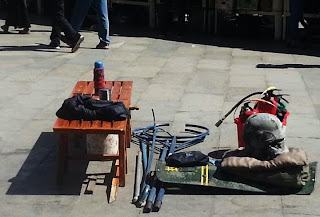China’s latest weapons against Tibetan self-immolators - Hooks and Rings
Phayul: With the ongoing wave of self-immolations in Tibet threatening to spread all over the plateau, Chinese security personnel have come up with specially designed tools to take down and overpower the self-immolators.
 Recent pictures taken in Lhasa, the ancient capital city of Tibet, show poles of different lengths that have either hooks or round metal rings of different sizes at one end.
Recent pictures taken in Lhasa, the ancient capital city of Tibet, show poles of different lengths that have either hooks or round metal rings of different sizes at one end.
The pictures released by Beijing-based Tibetan writer Woeser on a social networking site have reportedly been taken by Chinese tourists in July and August.
A close look at the pictures makes one realise that the hooks are designed to catch a self-immolator and the the round metal rings are meant for either holding the self-immolator’s burning body by the waist, by the neck or by the feet, depending on the size of the ring.
These new tools can be seen abundantly lying around Lhasa city along with fire extinguishers, outside police stations, and also being paraded by marching security personnel on the city streets.
Calling these new tools “Police Forks,” Woeser notes that security personnel all over Tibet have been armed with these “new weapons.”
In one of the picture, the police forks can be seen outside the Barkhor police station, opposite the Jokhang Temple, the site of the May 27 twin self-immolation protests by Dhargey, 25 and Dorjee Tseten, 19.
Chinese brutality, specially against Tibetan self-immolators, are not new.
Foreign journalists who were able to gain access to Ngaba, the eastern Tibet region at the centre of
the self-immolation protests, had earlier reported that Chinese security personnel were using “spiked batons” to overpower self-immolators.
One of the first international journalists to gain access to Ngaba, Jonathan Watts of the Guardian newspaper in March reported that Chinese paramilitaries were trying to “snuff out Tibetan resistance to Beijing's rule with spiked batons, semi-automatic weapons and fire extinguishers.”
A dramatic video footage shot on January 14 of the self-immolation protest by Losang Jamyang, 22, a former monk at the Andu monastery in Ngaba, shows Chinese security personnel mercilessly knocking down and kicking him while his body is still on fire.
There have been several other reports of similar instances where Chinese security forces have shot, brutally beaten, and maimed Tibetan self-immolators.
Since 2009, the ongoing wave of self-immolations has witnessed 45 Tibetans set themselves on fire demanding freedom in Tibet and the return of Tibetan spiritual leader the Dalai Lama from ex
 Recent pictures taken in Lhasa, the ancient capital city of Tibet, show poles of different lengths that have either hooks or round metal rings of different sizes at one end.
Recent pictures taken in Lhasa, the ancient capital city of Tibet, show poles of different lengths that have either hooks or round metal rings of different sizes at one end.The pictures released by Beijing-based Tibetan writer Woeser on a social networking site have reportedly been taken by Chinese tourists in July and August.
A close look at the pictures makes one realise that the hooks are designed to catch a self-immolator and the the round metal rings are meant for either holding the self-immolator’s burning body by the waist, by the neck or by the feet, depending on the size of the ring.
These new tools can be seen abundantly lying around Lhasa city along with fire extinguishers, outside police stations, and also being paraded by marching security personnel on the city streets.
Calling these new tools “Police Forks,” Woeser notes that security personnel all over Tibet have been armed with these “new weapons.”
In one of the picture, the police forks can be seen outside the Barkhor police station, opposite the Jokhang Temple, the site of the May 27 twin self-immolation protests by Dhargey, 25 and Dorjee Tseten, 19.
Chinese brutality, specially against Tibetan self-immolators, are not new.
Foreign journalists who were able to gain access to Ngaba, the eastern Tibet region at the centre of
the self-immolation protests, had earlier reported that Chinese security personnel were using “spiked batons” to overpower self-immolators.
One of the first international journalists to gain access to Ngaba, Jonathan Watts of the Guardian newspaper in March reported that Chinese paramilitaries were trying to “snuff out Tibetan resistance to Beijing's rule with spiked batons, semi-automatic weapons and fire extinguishers.”
A dramatic video footage shot on January 14 of the self-immolation protest by Losang Jamyang, 22, a former monk at the Andu monastery in Ngaba, shows Chinese security personnel mercilessly knocking down and kicking him while his body is still on fire.
There have been several other reports of similar instances where Chinese security forces have shot, brutally beaten, and maimed Tibetan self-immolators.
Since 2009, the ongoing wave of self-immolations has witnessed 45 Tibetans set themselves on fire demanding freedom in Tibet and the return of Tibetan spiritual leader the Dalai Lama from ex

Comments
Post a Comment